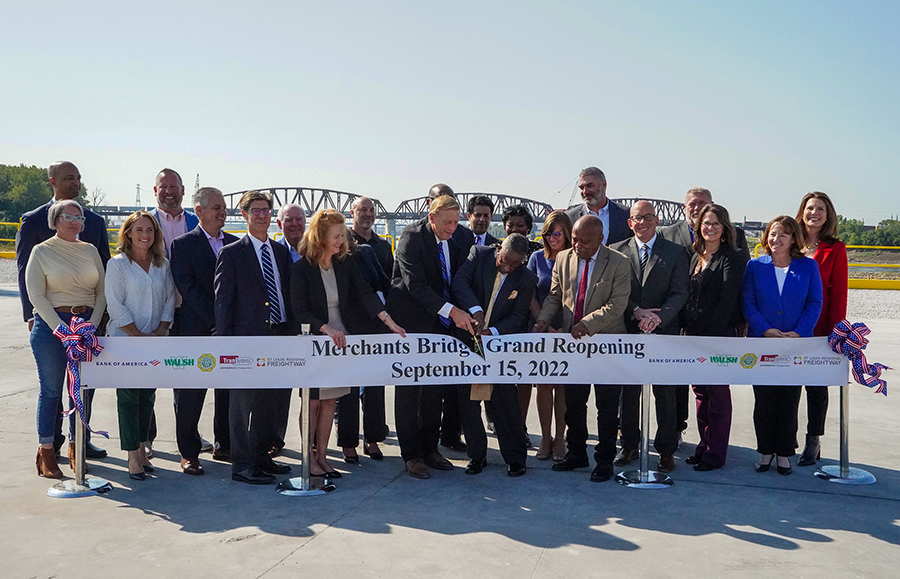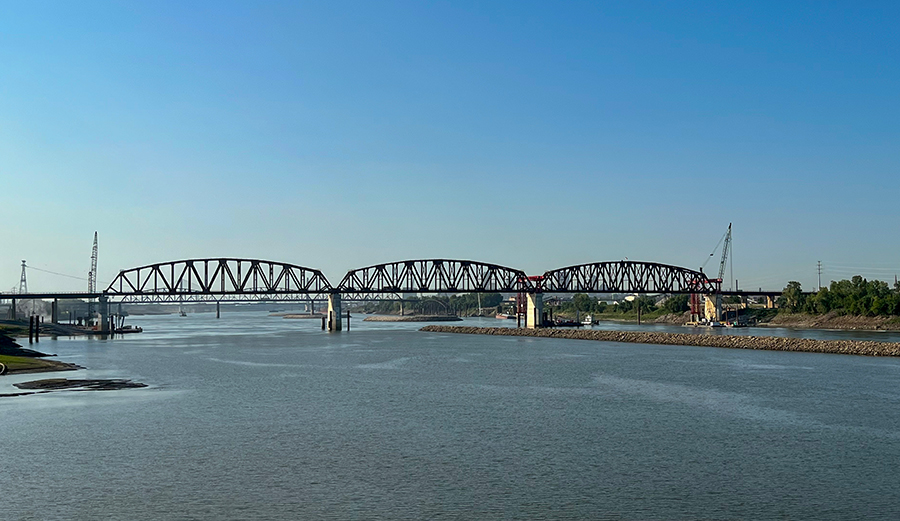September 2022
Walsh Construction Celebrates Grand Reopening of New Merchants Bridge
ST. LOUIS, MO - The 132-year-old Merchants Bridge celebrated its official grand reopening, following the completion of a landmark $222 million project to replace the vital artery that links Missouri and Illinois near downtown St. Louis. Dating back to the 1890s, the Merchants Bridge serves six Class I railroads and Amtrak as a bridge crossing across the Mississippi River at St. Louis, and replacement of the structure has been the bi-state St. Louis region’s top freight infrastructure priority since 2016.
The event marked the culmination of almost a decade of planning and advocacy and four years of reconstruction to modernize this critical infrastructure over the Mississippi River, which is one of the nation’s primary east-west rail corridors serving one of America’s largest rail hubs by car interchange volume and gross tonnage. This project will double the capacity on the bridge, so it can facilitate two freight trains at the same time and move freight faster, more cost effectively and more reliably.

Federal Railroad Administration (FRA) Administrator Amit Bose gathered with elected officials from Illinois and Missouri and representatives from Terminal Railroad Association of St. Louis (TRRA), Bi-State Development/St. Louis Regional Freightway, Bank of America St. Louis and Walsh Construction for the celebration, which was attended by approximately 150 invited guests.
The overall project included the removal and replacement of the three river-span trusses, seismically retrofitting the existing river piers, and improving the east approach. As a design-bid-build project, led by General Contractor Walsh Construction, reconstruction of the bridge used innovative project delivery methods that have improved safety and speeded completion while limiting bridge and river traffic outages. Through careful planning and coordination, the project team was able to limit the number of days of rail outages to just 30 days over the four years of the project. TranSystems and Burns & McDonnell served as the lead project engineers, while the steel was fabricated by Veritas Steel in Eau Claire, Wisconsin.
“In our 133-year history, TRRA had never previously built a bridge, but we were looking to the future and the growth in freight volumes expected in the next 30 years and knew that replacing the Merchants Bridge and adding the needed capacity would be essential for us to capture some of that increased volume and solidify the region’s positioning as global freight hub,” said Asim Raza, Chief Legal Officer, Director of Corporate Affairs for Terminal Railroad Association of St. Louis, which owns the bridge.

The Merchants Bridge required reconstruction due to speed, clearance and load restrictions. The old bridge would have been taken out of service in 2025 because of the age and condition of the historic infrastructure. Not replacing the Merchants Bridge would have resulted in rail traffic being rerouted out of the bi-state St. Louis region, potentially limiting shipping options for area rail-reliant businesses, increasing costs and lost jobs, and adding stress to an already over-burdened U.S. supply chain network.
"Walsh Construction is proud to work with TRRA and our project partners to unveil the latest renewal of American infrastructure – Merchants Bridge; a revived, high-quality and sustainable connection that is ready to accept freight and commuter rail traffic simultaneously," said Matt Walsh, co-chairman at The Walsh Group. "The men and women of this project have delivered an engineering marvel; from retrofitting the existing piers to installing three nine-million pound trusses, all while adhering to the highest standards of safety and quality."
The added capacity of the new bridge will help reduce the frequency of mile-long blockages along the St. Louis Riverfront and address one of the chokepoints in the nation’s supply chain network, positioning the St. Louis region to accommodate growing freight demands.
The Merchants Bridge also serves Amtrak and is a main component of the Chicago to St. Louis high-speed rail corridor. The ability to utilize both the eastbound and westbound tracks at the same time upon completion will be an advantage during delays on the route, helping to increase average Amtrak speeds through the downtown St. Louis portion of the trip. Prior to the reconstruction, only one train could cross the bridge at a time due to weight restrictions.